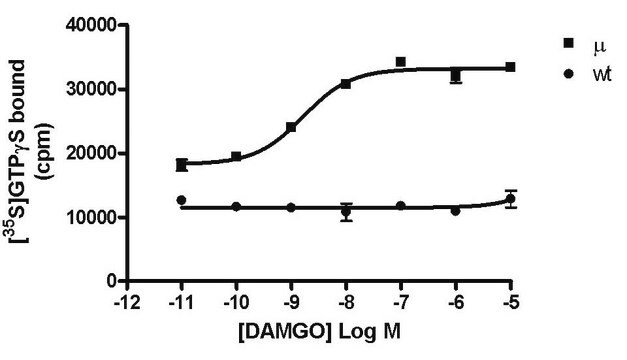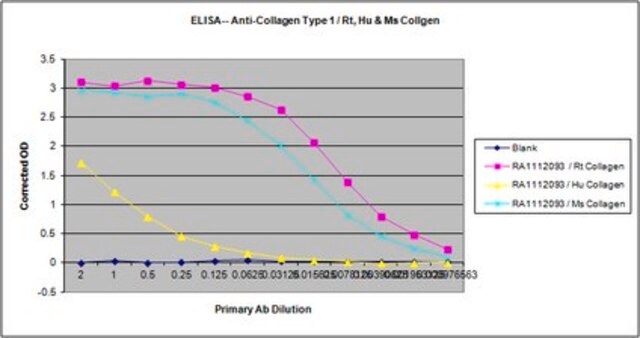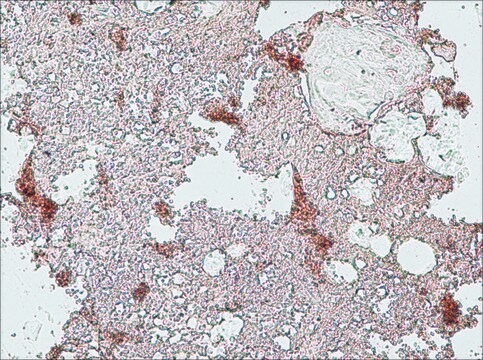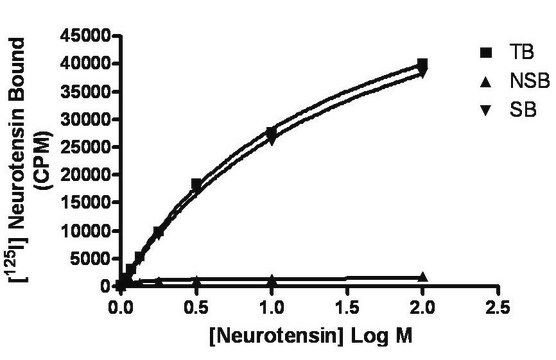HTS112M
ChemiScreen Recombinant Human Glucagon Receptor Membrane Preparation
Human glucagon / GCG GPCR membrane preparation for Radioligand binding Assays & GTPγS binding.
Synonym(s):
ChemiSCREEN Receptor Kit, Glucagon Receptor Membrane Prep, Human Glucagon Receptor Prep
Sign Into View Organizational & Contract Pricing
All Photos(2)
About This Item
UNSPSC Code:
41106514
eCl@ss:
32161000
NACRES:
NA.84
Recommended Products
biological source
human
Quality Level
recombinant
expressed in Chem-1 cells
manufacturer/tradename
ChemiScreen
Chemicon®
technique(s)
ligand binding assay: suitable (GTPγS)
radioligand binding assay (RLBA): suitable
NCBI accession no.
UniProt accession no.
shipped in
dry ice
General description
TRANSFECTION: Full-length human GCGR cDNA encoding Glucagon Receptor
HOST CELLS: Chem-1, an adherent mammalian cell line with no endogenous glucagon receptor expression.
HOST CELLS: Chem-1, an adherent mammalian cell line with no endogenous glucagon receptor expression.
Glucagon is a 29-amino acid peptide that stimulates glycogenolysis and gluconeogenesis in the liver to increase blood glucose. The receptor for glucagon is a class 2 (or class B) GPCR that signals through Gs to stimulate cAMP production (Mayo et al., 2003). Mice lacking the glucagon receptor have mild hypoglycemia after fasting, and exhibit hyperplasia of pancreatic α-cells (Gelling et al., 2003). Because of its role in promoting hyperglycemia, the glucagon receptor presents a potential target for treatment of diabetes. Chemicon′s glucagon receptor membrane preparations are crude membrane preparations made from our proprietary stable recombinant cell lines to ensure high-level of GPCR surface expression; thus, they are ideal HTS tools for screening of antagonists of glucagon receptor interactions and its ligands. The membrane preparations exhibit a Kd of 3.09 nM for [125I]-glucagon. With 1 nM [125I]-glucagon, 5 or 10 μg/well glucagon receptor Membrane Prep yields greater than 10-fold signal-to-background ratio.
Quality
SPECIFICATIONS:
1 unit = 5 μg
Bmax for [125I] glucagon binding: 16.7 pmol/mg protein
Kd for [125I] glucagon binding: ~ 3.09 nM
Signal:background and specific binding values obtained in a competition binding assay with varying amounts of Glucagon receptor membrane prep:
1 unit = 5 μg
Bmax for [125I] glucagon binding: 16.7 pmol/mg protein
Kd for [125I] glucagon binding: ~ 3.09 nM
Signal:background and specific binding values obtained in a competition binding assay with varying amounts of Glucagon receptor membrane prep:
| 10 µg/well | 5 µg/well | |
|---|---|---|
| Signal:Background | 10.1 | 35 |
| Specific Binding (cpm) | 33315 | 36252 |
Specifications
Inucbation Conditions
RECOMMENDED ASSAY CONDITIONS: Membranes are mixed with radioactive ligand and unlabeled competitor in binding buffer in a nonbinding 96-well plate, and incubated for 1-2 h. Prior to filtration, a GF/C 96-well filter plate is coated with 0.33% polyethyleneimine for 30 min, then washed with 50mM HEPES, pH 7.4, 0.5% BSA. Binding reaction is transferred to the filter plate, and washed 3 times (1 mL per well per wash) with Wash Buffer. The plate is dried and counted.
• Binding buffer: 50 mM Hepes, pH 7.4, 5 mM MgCl2, 1 mM CaCl2, 0.2% BSA, filtered and stored at 4°C
• Radioligand: [125I]-glucagon (Perkin Elmer#:NEX-207)
• Wash Buffer: 50 mM Hepes, pH 7.4, 500mM NaCl , 0.1% BSA, filtered and stored at 4°C.
One package contains enough membranes for at least 200 assays (units), where a unit is the amount of membrane that will yield greater than 10-fold signal:background with [125I]-labeled glucagon at 1 nM
RECOMMENDED ASSAY CONDITIONS: Membranes are mixed with radioactive ligand and unlabeled competitor in binding buffer in a nonbinding 96-well plate, and incubated for 1-2 h. Prior to filtration, a GF/C 96-well filter plate is coated with 0.33% polyethyleneimine for 30 min, then washed with 50mM HEPES, pH 7.4, 0.5% BSA. Binding reaction is transferred to the filter plate, and washed 3 times (1 mL per well per wash) with Wash Buffer. The plate is dried and counted.
• Binding buffer: 50 mM Hepes, pH 7.4, 5 mM MgCl2, 1 mM CaCl2, 0.2% BSA, filtered and stored at 4°C
• Radioligand: [125I]-glucagon (Perkin Elmer#:NEX-207)
• Wash Buffer: 50 mM Hepes, pH 7.4, 500mM NaCl , 0.1% BSA, filtered and stored at 4°C.
One package contains enough membranes for at least 200 assays (units), where a unit is the amount of membrane that will yield greater than 10-fold signal:background with [125I]-labeled glucagon at 1 nM
Physical form
Liquid in packaging buffer: 50 mM Tris pH 7.4, 10% glycerol and 1% BSA; no preservatives.
Packaging method: Membrane proteins were adjusted to 0.5 mg/ml in 1 ml packaging buffer, rapidly frozen, and stored at -80°C.
Packaging method: Membrane proteins were adjusted to 0.5 mg/ml in 1 ml packaging buffer, rapidly frozen, and stored at -80°C.
Legal Information
CHEMICON is a registered trademark of Merck KGaA, Darmstadt, Germany
Storage Class Code
12 - Non Combustible Liquids
WGK
WGK 2
Flash Point(F)
Not applicable
Flash Point(C)
Not applicable
Certificates of Analysis (COA)
Search for Certificates of Analysis (COA) by entering the products Lot/Batch Number. Lot and Batch Numbers can be found on a product’s label following the words ‘Lot’ or ‘Batch’.
Already Own This Product?
Find documentation for the products that you have recently purchased in the Document Library.
Yuping Xiao et al.
The journal of obstetrics and gynaecology research, 46(6), 864-875 (2020-03-24)
High-expressed miR-330-3p in gestational diabetes mellitus (GDM) patients was reported. However, the role and mechanism of miR-330-3p in GDM are rarely reported. In this research, we aim to investigate the effects of miR-330-3p on GDM. MiR-330-3p expression in the GDM
Qiong Li et al.
International journal of stem cells, 14(4), 434-446 (2021-08-31)
MiR-148a-3p has been reported to regulate the differentiation of marrow stromal cell osteoblast. In this study, whether miR-148a-3p regulated the odontoblastic differentiation of human dental pulp stem cells (hDPSCs) or not was explored. The hDPSCs were isolated and identified via
Kelly E Mayo et al.
Pharmacological reviews, 55(1), 167-194 (2003-03-05)
Peptide hormones within the secretin-glucagon family are expressed in endocrine cells of the pancreas and gastrointestinal epithelium and in specialized neurons in the brain, and subserve multiple biological functions, including regulation of growth, nutrient intake, and transit within the gut
Our team of scientists has experience in all areas of research including Life Science, Material Science, Chemical Synthesis, Chromatography, Analytical and many others.
Contact Technical Service







